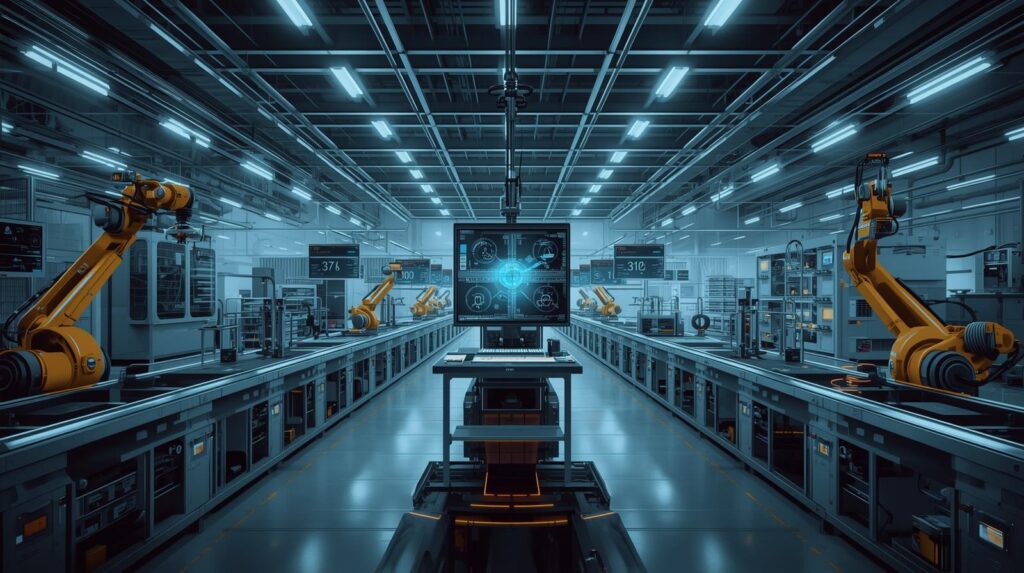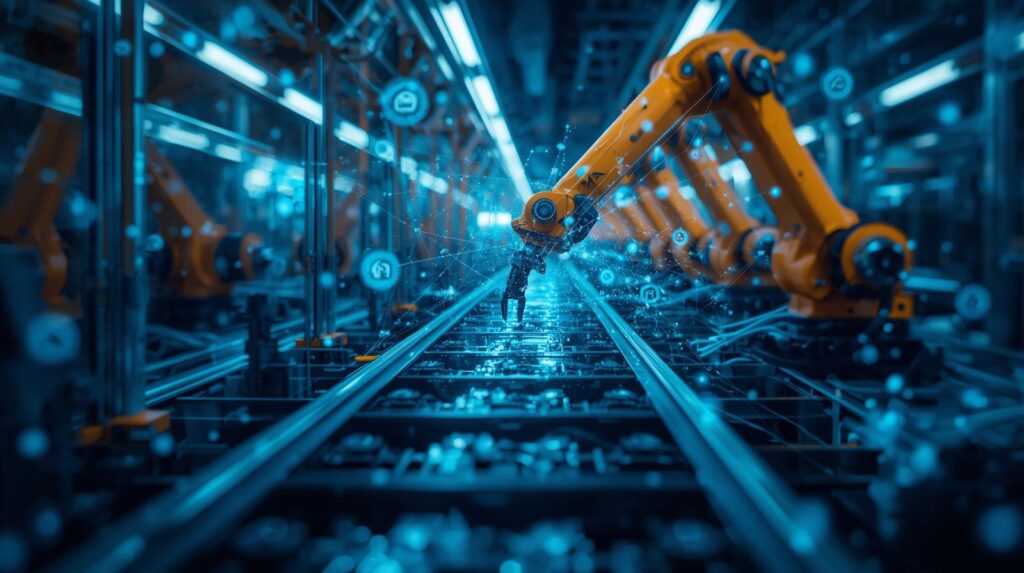The manufacturing world is in the midst of a profound transformation, a fourth industrial revolution often termed Industry 4.0. At the very heart of this seismic shift lies the Industrial Internet of Things (IIoT). This network of interconnected devices, sensors, and machinery is not just an upgrade; it’s a complete reimagining of how factories operate, produce, and innovate. The convergence of operational technology (OT) and information technology (IT) through IIoT in Manufacturing and Smart Factories is creating unprecedented levels of efficiency, productivity, and intelligence. This guide delves deep into the world of IIoT, exploring its core components, monumental benefits, practical applications, and the path to successful implementation.
The global Industrial IoT Market Market was valued at USD 119.4 billion in 2024 and is projected to grow from USD 198.2 billion in 2025 to USD 286.3 billion by 2029, at a CAGR of 8.1% during the forecast period.

The Core Components of an IIoT Ecosystem
A functional IIoT system is built upon a layered architecture, each layer playing a critical role in the data lifecycle.
1. The Physical Layer: Devices and Sensors
This is the foundation. It includes the smart devices embedded on the factory floor: sensors that measure temperature, pressure, vibration, and humidity; RFID tags that track inventory; actuators that control valves and motors; and GPS for logistics. These are the “eyes and ears” of the operation, continuously generating raw data.
2. The Network Layer: Connectivity
Data from the physical layer needs to be transmitted. This layer encompasses the communication protocols and networks that facilitate this transfer. This includes wired fieldbuses (PROFIBUS, Modbus) and a range of wireless technologies like Wi-Fi, Bluetooth, Cellular (4G/5G), and specialized low-power options like LoRaWAN and Zigbee, chosen based on range, bandwidth, and power requirements.
3. The Data Layer: Cloud and Edge Platforms
Once transmitted, data must be processed and stored. This happens at the edge (on local servers or gateways near the machines for low-latency processing) and in the cloud (for large-scale storage and heavy computational analysis). Platforms like AWS IoT SiteWise, Azure IoT Hub, and private cloud solutions form this critical backbone.
4. The Application Layer: Analytics and Intelligence
This is where data is transformed into actionable insights. Software applications use advanced analytics, machine learning (ML), and artificial intelligence (AI) to process the data, identify patterns, predict outcomes, and generate visualizations through dashboards and reports. This layer enables predictive maintenance, digital twins, and real-time optimization.
5. The User Layer: People and Interfaces
The final layer presents the analyzed information to the end-users—plant managers, operators, and executives—via Human-Machine Interfaces (HMIs), desktop dashboards, or mobile alerts. This empowers them to make data-driven decisions, from adjusting a machine parameter to overhauling a supply chain strategy.
Key Benefits of Implementing IIoT in Manufacturing and Smart Factories
The integration of IIoT in Manufacturing and Smart Factories delivers tangible and significant returns on investment across the entire production value chain.
Predictive Maintenance is a game-changer. Instead of following a rigid schedule or waiting for a breakdown (reactive maintenance), IIoT sensors monitor equipment condition in real-time. By analyzing vibration, thermal, and acoustic data, the system can predict a potential failure days or weeks in advance, allowing maintenance to be scheduled during planned downtime, thus avoiding catastrophic failures and reducing costs.
Enhanced Quality Control is another critical advantage. IIoT vision systems and sensors can perform 100% inline inspection of products, detecting microscopic defects invisible to the human eye. Data from the production process can be correlated with quality outcomes to identify the root cause of defects, enabling continuous process improvement and dramatically reducing scrap and rework rates.
Optimized Supply Chain and Logistics see massive improvements. IIoT provides end-to-end visibility. Sensors track raw materials from suppliers, monitor inventory levels in warehouses in real-time, and provide live location data for in-transit goods. This transparency allows for just-in-time inventory management, reduces stockouts and overstocking, and enhances overall supply chain resilience.
Increased Overall Equipment Effectiveness (OEE) is a primary goal. IIoT directly measures the three components of OEE: availability (downtime), performance (operating speed), and quality (defect rate). By providing a clear, data-backed view of these metrics, manufacturers can identify bottlenecks, optimize production cycles, and significantly boost the productivity of their existing assets.
Improved Worker Safety and Sustainability are crucial benefits. Wearable IIoT devices can monitor workers’ vital signs and environmental conditions, alerting them to hazardous gas leaks or excessive heat. Furthermore, IIoT systems optimize energy consumption by monitoring the power usage of individual machines and entire facilities, contributing to both cost reduction and sustainability goals.

Real-World Applications of IIoT Across the Manufacturing Floor
The theory of IIoT in Manufacturing and Smart Factories comes to life through powerful, practical applications.
Smart Asset Management involves tagging all critical assets and tools with RFID or BLE tags. This allows for real-time location tracking, preventing loss and reducing time spent searching for equipment. It also enables digital checklists and maintenance history logs accessible via a simple scan.
Digital Twin technology creates a virtual, dynamic replica of a physical asset, process, or system. The digital twin is continuously updated with data from its physical counterpart, allowing engineers to run simulations, test scenarios, and optimize performance without interrupting the actual production line. This is invaluable for new product introduction and process redesign.
Remote Monitoring and Control empower experts to oversee operations from anywhere in the world. A specialist in Germany can diagnose a problem on a machine in a factory in Mexico, reducing travel costs and mean time to repair (MTTR). Operators can also receive augmented reality (AR) instructions overlaid on their field of view through smart glasses, guided by IIoT data.
Autonomous Mobile Robots (AMRs) and Agile Robotics are fueled by IIoT. These robots navigate dynamically through factories using IIoT data from sensors and central systems to transport materials, pick items, and collaborate safely with human workers, creating flexible and efficient material handling systems.
Energy Management is streamlined through IIoT. Smart meters and submeters attached to individual machines monitor energy consumption patterns. Analytics software can then identify energy waste, recommend optimal operating schedules to leverage off-peak tariffs, and automatically shut down idle equipment, leading to substantial cost and carbon footprint reduction.
Download PDF Brochure @
https://www.marketsandmarkets.com/pdfdownloadNew.asp?id=129733727
Overcoming the Challenges of IIoT Implementation
Despite its promise, adopting IIoT in Manufacturing and Smart Factories is not without hurdles. A strategic approach is required to navigate these challenges.
Cybersecurity remains the paramount concern. Connecting industrial control systems to the internet expands the attack surface. A robust security strategy encompassing network segmentation, regular firmware updates, strong encryption, and continuous threat monitoring is non-negotiable to protect critical infrastructure.
Legacy System Integration is a common technical hurdle. Many factories operate with decades-old machinery that lacks modern connectivity. Retrofitting these assets with appropriate sensors and gateways is often necessary, requiring expertise to ensure seamless data acquisition without compromising machine integrity or safety.
Data Overload and Skill Gaps can overwhelm organizations. The sheer volume of data generated can be paralyzing without a clear strategy. Furthermore, there is a significant shortage of talent skilled in data science, IIoT architecture, and cybersecurity. Investing in data governance frameworks and employee upskilling is essential.
High Initial Investment and ROI Calculation can be a barrier to entry. The cost of hardware, software, connectivity, and integration services can be substantial. Companies must build a strong business case with clear KPIs and a phased implementation plan to demonstrate incremental value and secure executive buy-in.
The Future of IIoT in Manufacturing and Smart Factories
The evolution of IIoT in Manufacturing and Smart Factories is accelerating, driven by advancements in other technologies. The rollout of 5G networks will provide the ultra-reliable, low-latency communication (URLLC) needed for mission-critical control and real-time automation. AI and Machine Learning will move from descriptive analytics (“what happened”) to prescriptive analytics (“what should we do”), enabling fully autonomous decision-making and self-optimizing production systems. Furthermore, the rise of edge computing will see more intelligence deployed directly on the factory floor, processing data locally for faster response times and reduced cloud dependency. This will pave the way for increasingly adaptive, resilient, and sustainable manufacturing ecosystems that can respond dynamically to changing market demands.
Explore In-Depth Semiconductor & Electronics Market Research:
https://www.marketsandmarkets.com/semiconductorand-electonics-market-research-87.html
FAQs
Q1: What is the difference between IoT and IIoT?
A: IoT (Internet of Things) is a broad term for interconnected consumer devices (like smart home products). IIoT (Industrial Internet of Things) is a subset of IoT focused specifically on industrial applications like manufacturing, oil and gas, and energy. IIoT requires higher levels of robustness, security, and precision.
Q2: How does IIoT improve worker safety?
A: IIoT enhances safety through wearable devices that monitor worker vitals and environmental sensors that detect toxic gas leaks or unsafe temperatures. It can also geofence hazardous areas, sending alerts if a worker enters unsupervised, and ensure safety protocols are followed through connected equipment.
Q3: Is IIoT only for large enterprises?
A: No. While large companies were early adopters, the decreasing cost of sensors and cloud computing has made IIoT solutions accessible and scalable for small and medium-sized enterprises (SMEs). Many SaaS (Software-as-a-Service) platforms offer affordable, subscription-based models.
Q4: What is the first step in starting an IIoT journey?
A: The first step is always to identify a specific business problem or opportunity, such as reducing unplanned downtime or improving quality. Start with a small, well-defined pilot project to demonstrate value, measure ROI, and learn before scaling to a full-factory implementation.
Q5: How is data from IIoT devices secured?
A: IIoT data is secured through a multi-layered approach: encrypting data both at rest and in transit, implementing strong network security firewalls and segmentation, using secure authentication methods for devices, and continuously monitoring the network for anomalous activity.
See The Latest Semiconductor Reports:
Radiation Hardened Electronics Market Size, Share & Trends : https://www.marketsandmarkets.com/Market-Reports/radiation-hardened-electronics-market-44047967.html
Smart Appliances Market Size, Share & Trends : https://www.marketsandmarkets.com/Market-Reports/smart-appliances-market-8228252.html
Ultra-low-power Microcontroller Market Size, Share & Trends : https://www.marketsandmarkets.com/Market-Reports/ultra-low-power-microcontroller-market-206772623.html
Quantum Computing Market Size, Share & Trends : https://www.marketsandmarkets.com/Market-Reports/quantum-computing-market-144888301.html
Cold Chain Monitoring Market Size, Share & Trends : https://www.marketsandmarkets.com/Market-Reports/cold-chain-monitoring-market-161738480.html
Printed Electronics Market Size, Share & Trends : https://www.marketsandmarkets.com/Market-Reports/printed-electronics-market-197.html
